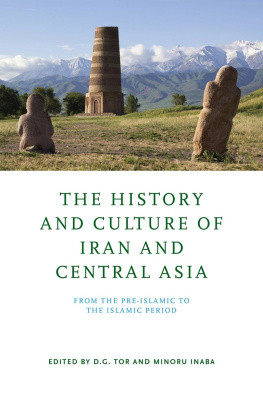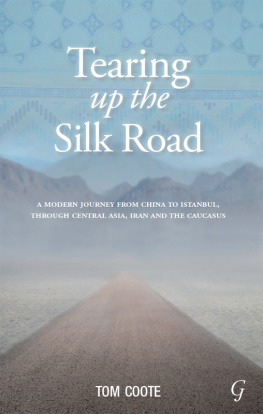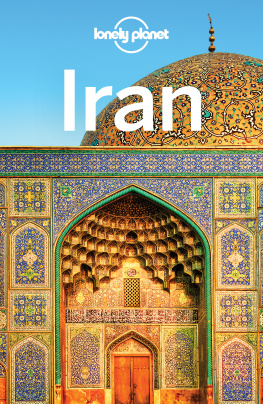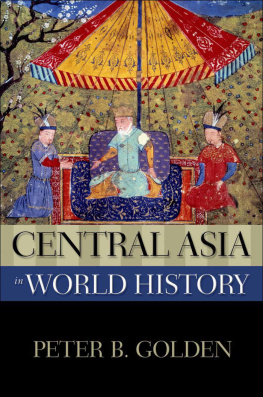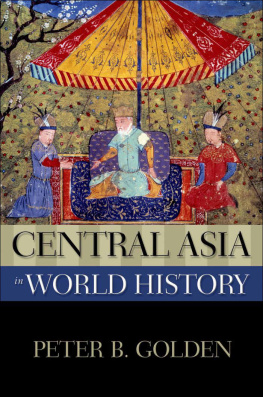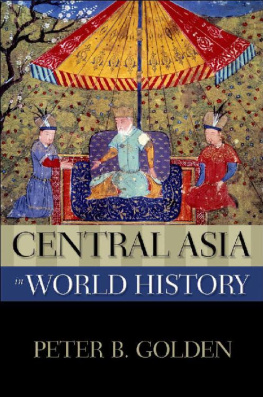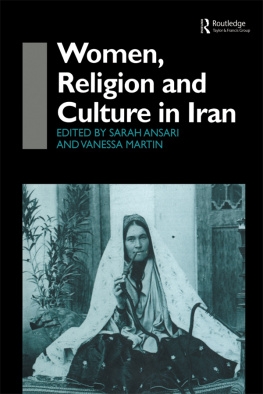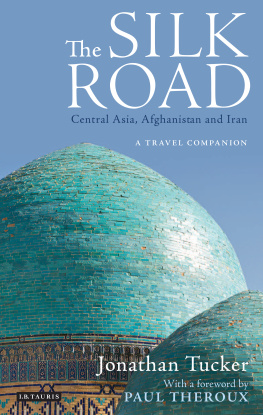D. G. Tor - The History and Culture of Iran and Central Asia
Here you can read online D. G. Tor - The History and Culture of Iran and Central Asia full text of the book (entire story) in english for free. Download pdf and epub, get meaning, cover and reviews about this ebook. year: 2022, publisher: University of Notre Dame Press, genre: Romance novel. Description of the work, (preface) as well as reviews are available. Best literature library LitArk.com created for fans of good reading and offers a wide selection of genres:
Romance novel
Science fiction
Adventure
Detective
Science
History
Home and family
Prose
Art
Politics
Computer
Non-fiction
Religion
Business
Children
Humor
Choose a favorite category and find really read worthwhile books. Enjoy immersion in the world of imagination, feel the emotions of the characters or learn something new for yourself, make an fascinating discovery.
- Book:The History and Culture of Iran and Central Asia
- Author:
- Publisher:University of Notre Dame Press
- Genre:
- Year:2022
- Rating:3 / 5
- Favourites:Add to favourites
- Your mark:
- 60
- 1
- 2
- 3
- 4
- 5
The History and Culture of Iran and Central Asia: summary, description and annotation
We offer to read an annotation, description, summary or preface (depends on what the author of the book "The History and Culture of Iran and Central Asia" wrote himself). If you haven't found the necessary information about the book — write in the comments, we will try to find it.
D. G. Tor: author's other books
Who wrote The History and Culture of Iran and Central Asia? Find out the surname, the name of the author of the book and a list of all author's works by series.
The History and Culture of Iran and Central Asia — read online for free the complete book (whole text) full work
Below is the text of the book, divided by pages. System saving the place of the last page read, allows you to conveniently read the book "The History and Culture of Iran and Central Asia" online for free, without having to search again every time where you left off. Put a bookmark, and you can go to the page where you finished reading at any time.
Font size:
Interval:
Bookmark:
THE HISTORY AND CULTURE OF IRAN AND CENTRAL ASIA
The History and Culture of Iran and Central Asia

From the Pre-Islamic to the Islamic Period
EDITED BY
D. G. Tor and Minoru Inaba
University of Notre Dame Press
Notre Dame, Indiana
Copyright 2022 by the University of Notre Dame
University of Notre Dame Press
Notre Dame, Indiana 46556
All Rights Reserved
Published in the United States of America
Library of Congress Control Number: 2021948795
ISBN: 978-0-268-20209-5 (Harback)
ISBN: 978-0-268-20211-8 (WebPDF)
ISBN: 978-0-268-20208-8 (Epub)
This e-Book was converted from the original source file by a third-party vendor. Readers who notice any formatting, textual, or readability issues are encouraged to contact the publisher at
CONTENTS
| The Enduring Significance of the Iranian World in the First Millennium CE: Transformation and Continuity D. G. Tor |
| Types of Town Planning in Ancient Iranian Cities: New Considerations Frantz Grenet |
| The Proto-Sogdian Inscriptions of Kultobe: New Fragments and New Reconstructions Nicholas Sims-Williams |
| Xian Temples of the Sogdian Colonies in China: A Study Based on Archaeological Material Etsuko Kageyama |
| Three Scenarios for the Historical Background of the Xian Sino-Pahlavi Inscription: Post-Sasanian Zoroastrian Traders? Yutaka Yoshida |
| The Arab Conquest and the Collapse of the Sogdian Civilization Michael Shenkar |
| Central Asia in the Mid-Eighth Century: Wukongs Itinerary toward India Minoru Inaba |
| Evolution of the Habitat in Paykend Rocco Rante |
| Notes on Islamization Narratives in the Fail-i Balkh Arezou Azad |
| The New Garden of the Amr: Smnid Land Development at the Fringes of the Bukhr Oasis Sren Stark |
| Al-Thalibs Iranian Past: Assimilationand Aesthetics Louise Marlow |
| Representations of the Pre-Islamic Pastin Early Persian Court Poetry:The Art of Celebration Gabrielle van den Berg |
| From Turkistan to Tibet: The Qarakhanidsand the Tsongkha Kingdom Dilnoza Duturaeva |
FIGURES
ACKNOWLEDGMENTS
The editors are deeply grateful to the many organizations and individuals that made possible the scholarly exchange both of the conference and of this volume. The fruits of this project are the outcome of the scientific cooperation agreement signed in 2016 between Kyoto University and the University of Notre Dame. Without the generous support of the Medieval Institute and the Institute for Scholarship in the Liberal Arts at the University of Notre Dame, and of Kyoto Universitys Institute for Research in Humanities and Graduate School of Letters, this undertaking would never have been realized. One of us, D. G. Tor, is also indebted to generous fellowship funding provided by the American Council of Learned Societies.
We are above all grateful to both the original conference participants and to the contributors to this volume, whose groundbreaking scholarship constitutes the heart of this endeavor.
CHAPTER 1
The Enduring Significance of the Iranian World in the First Millennium CE
Transformation and Continuity
D. G. TOR
One of the most formative times and places in world history was the Iranian linguistic and cultural world of the first millennium CE. This cultural zone comprised what one might call Greater Inner Asia: roughly, the classical lands of Iran, including Khursn, to the end of the Iranian Plateau in the west; the ancient lands of Bactria and Soghdia, which include all or part of todays Afghanistan, Turkmenistan, Uzbekistan, Tjikistn, Kyrgyzstan, and Kazakhstan, to the east and north; and the adjacent nomadic steppes that were under their influence, up to the borders of China in the east. In fact, proportionally to its historical significance, Iranian Inner Asia in this period is probably the least known and most grossly understudied time and place in world history.
Indeed, the Iranian civilizational world at this time was comparable in size, scope, cultural creativity, and influence to the Roman one; yet today only a greatly truncated and diminished remnant of it survives: the Islamic Republic of Iran, along with Afghanistan and Tjikistn. For among many other historically significant events, this time and place produced great movements of people, goods, ideas, and religions, from the Soghdians
This transformation from Iranian to Turkic predominance was a protracted, centuries-long process. The end and culmination of itthe Seljuq, Mongol, and Timurid conquests of all of the lands that had once constituted the Iranian cultural worldfalls outside the scope of the millennium covered in this volume, but the first stage of the process of the transformation of Central Asia from a civilizationally Iranian population to a Turkic one, including the beginning of the conquest stage, signaled by the Qarakhanid Turkmen conquest of Transoxiana in 999, certainly falls within its purview.
The second of the greatest transformations that took place was religious and cultural. The victory of Islam over Buddhism and Christianity in Iran and the steppes
Iranian Inner Asia in the first millennium also produced some of the greatest empires the world has known, from the Hephthalite Empire to the Sasanian Empirewhich was the most formidable enemy of the Roman Empireto the Abbsid Caliphate of Islam, all of which profoundly affected not only every surrounding civilization, but also those much farther afield, throughout the continents of Europe, Asia, and Africa.
This last historical occurrence in particular, the Abbsid Revolution, was of incalculable importance to subsequent world history. Taking place around AD 750, the Abbsid dynasty, heading a messianic movement whose headquarters were located in Marw, in todays Turkmenistan, and whose armies came from Khursn (todays Uzbekistan, Afghanistan, and parts of both Iran and Turkmenistan),
Despite the astonishing richness, historical importance, and cultural fecundity of the Iranian world in the first millennium, and the fact that it is vital to understanding world history in both Late Antiquity and the Middle Ages, the Iranian world of this era has been, and still is, woefully understudied; due, no doubt, to the very high scholarly demands required for such study of Iranian Central Asia in particular. Such an attempt requires not only collaboration among historians, philologists, paleographers, archaeologists, and numismatists, but also the knowledge of many different languages, some archaic, ranging from Bactrian and Soghdian to classical Arabic, Persian, and Chinese. When one undertakes to examine change and transformation from the pre-Islamic period of late antiquity through the early Islamic period (up until the eleventh century, when Turkic political domination entered a new phase), matters become even more complex and the obstacles more formidable, since it requires full mastery of both civilizational worlds.
The rationale behind this volume, therefore, is that such an undertaking can only be accomplished collaboratively, by bringing together the various experts on these two completely different eras and the discrete linguistic areas: no one can possibly be a real master of all of the various demanding areas of study. This kind of collaborative effort to cast light on the transition from pre-Islamic to Islamic Iran and Inner Asia is therefore also, unfortunately, rare, since the resources required for bringing the various experts together from the far-flung corners of the earth are considerable. Such an enterprise, in fact, has been undertaken only thrice before the present volume, and the aim of the present work is to extend a bit farther the trailblazing path laid out by those works.
Next pageFont size:
Interval:
Bookmark:
Similar books «The History and Culture of Iran and Central Asia»
Look at similar books to The History and Culture of Iran and Central Asia. We have selected literature similar in name and meaning in the hope of providing readers with more options to find new, interesting, not yet read works.
Discussion, reviews of the book The History and Culture of Iran and Central Asia and just readers' own opinions. Leave your comments, write what you think about the work, its meaning or the main characters. Specify what exactly you liked and what you didn't like, and why you think so.

